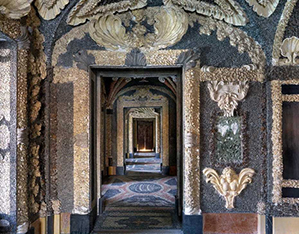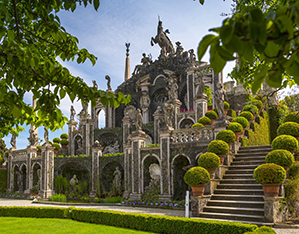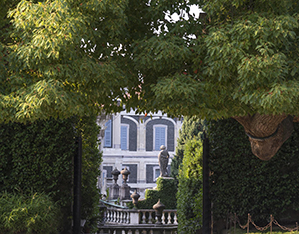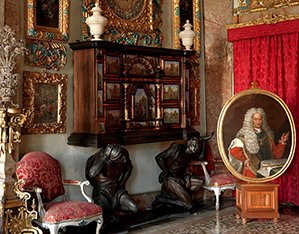This triumph of the Baroque (and popular destination on the Grand Tour) offers a lively sequence of fine mineral and plant environments overlooking a lake, a veritable garden-based Wunderkammer packed with charm and fascinating things to see.
In the late 15th century, Francesco Colonna wrote about a magnificent island-garden in his work of literary fiction, “Hypnerotomachia Poliphili”, which was published in Venice. Almost a century and a half later, Isola Bella made his musings a reality, albeit without the perfectly circular shape in the book. What the island on Lake Maggiore does share with the fictional garden is a desire to bend nature to architectural form, embodying the essence of the Italian Renaissance and Baroque gardens. Carlo III Borromeo began work on the garden in 1630, on a small island with unproductive soil, inhabited by fishermen. He renamed it “Isabella Island” in homage to his wife. The system of ten terraces laid out over the high, rocky part of the island makes gives it the look of a vessel. In part recalling ancient hanging gardens, a stepped pyramid hosts espaliers of fast-growing citrus trees with beautiful blooms, which thanks to the lake’s microclimate grow in the ground rather than in pots that need to be sheltered in a greenhouse over the winter. The complex reached its current configuration after Vitaliano VI commissioned work between 1650 and 1690 to harmonize the large palazzo and the small fishing village. The garden’s terraces and architectural backdrops are packed with sculptures celebrating Vitaliano VI’s personage and lineage, making a perfect place to put on festivals, music and theatrical performances. Over the centuries, the garden’s vegetation, notably its many yews and boxwoods, has been meticulous pruned by the gardeners. The garden has been further enriched with monumental exotic specimens and botanical rarities, some of which grow in its 19th-century greenhouses.
Highlights

Grottoes
A hallmark feature in every Italian Renaissance and Baroque garden, decorated with rocks, mosaics and shells to evoke the marriage of architecture and nature, Vitaliano VI Borromeo commissioned these grottoes so his guests could stay cool and spend time together. Occupying a large portion of the palazzo’s base on Isola Bella, Stendhal was an admirer.

Teatro Massimo
The garden’s single most dramatic architectural feature is adorned with allegorical sculptures depicting the lake and the Rivers Ticino and Po, surmounted by the Borromeo family’s heraldic crest, a statue of the Unicorn, combining the founding elements of every garden: Art and Nature. The garden’s terraces are adorned with sculptures depicting the Seasons that bear the Borromeo family’s insignia.

The Great Tree
Among the garden’s botanical treasures is a huge camphor tree (Cinnamomum camphora). Planted in 1819, Antonio Fogazzaro mentioned it in his novel, “The Little World of The Past”.

Palazzo Borromeo
Built in the mid-17th century for Vitaliano VI Borromeo, over the centuries the princely residence has been enriched with a multitude of artistic treasures. Its splendid halls feature Baroque furniture, rare Flemish tapestries in silk and gold, and an impressive picture gallery.
 Isola Bella
Contacts
Isola Bella
Contacts
 Isola Bella
Opening times and prices
Isola Bella
Opening times and prices
Opening hours
The 2021 opening season of the Terre Borromeo museum sites is scheduled from March 19th to November 1st. According to ministerial and regional dispositions for the COVID emergency, days and hours could be subject to variations. For further information please consult the website of the garden or contact the call center: 0323.933479
Pricing
Isola Bella (palace and gardens)
- single adults: 18 €
- single kids: 11 €
- group adults: 16 €
- children’s group: 9 €
Isola Bella + Isola Madre
- single adults: 25 €
- single kids: 13 €
- group adults: 22 €
- children’s group: 11 €
Isola Bella + Rocca di Angera
- single adults: 22 €
- single kids: 13 €
- group adults: 20 €
- children’s group: 12 €
Isola Bella + Parco Pallavicino
- single adults: 22 €
- single kids: 13 €
- group adults: 20 €
- children’s group: 12 €
For more information download the pdf table with garden rates.
 Isola Bella
How to get there
Isola Bella
How to get there
Address
Isola Bella
28838 , Stresa (VB)
Latitude: 45.895438
Longitude: 8.52684
How to arrive by road
From the autostrada dei Laghi in the direction of Gravellona Toce, exit at Carpugnino, following the signs for Stresa. You can park in Piazza Marconi in Stresa and from here take one of the boats to reach the Borromean Islands. Alternatively, you can leave your car in the square in Carciano in front of the pier.
How to arrive by train
State Railways, Milan-Sempione line, Stresa stop. The station is about 850 m from Piazza Marconi. By Ferrovie Nord, Milan-Laveno line, Laveno stop.
How to arrive by bus
Line VB Arona Milan: departure from Milan Lampugnano, stop B5. Or Verbania – Stresa – Malpensa, on reservation. For further information consult the website.
Additional directions
By plane:
- Distance from the main airports: Turin Caselle 140km – Milan Malpensa 50km – Milan Linate 110km – Bergamo Orio Al Serio 130km.
By ferry:
- The boats leave from the main towns on the lake. For further information Navigazione Lago Maggiore – public scheduled service. A non-scheduled public motorboat service is also available.
 Isola Bella
Services/Accessibility
Isola Bella
Services/Accessibility
Services
Isola Bella offers many places where you can relax and enjoy the local dishes.
- the ideal cafeteria for breakfast, lunch or aperitifs
- the Bistrot "Il Fornello Bottega con Cucina", a gourmet space on the island, born from the renovation of the fishermen's houses in the old village. It owes its name to the oven in which the fishing nets were cooked. The Bistrot has joined the Slow Food Alliance of Chefs, a network that defends food biodiversity around the world.
Isola Bella offers many places where you can relax and enjoy the local dishes.
- the ideal cafeteria for breakfast, lunch or aperitifs
- the Bistrot "Il Fornello Bottega con Cucina", a gourmet space on the island, born from the renovation of the fishermen's houses in the old village. It owes its name to the oven in which the fishing nets were cooked. The Bistrot has joined the Slow Food Alliance of Chefs, a network that defends food biodiversity around the world.
Isola Bella offers many places where you can relax and enjoy the local dishes.
- the ideal cafeteria for breakfast, lunch or aperitifs
- the Bistrot "Il Fornello Bottega con Cucina", a gourmet space on the island, born from the renovation of the fishermen's houses in the old village. It owes its name to the oven in which the fishing nets were cooked. The Bistrot has joined the Slow Food Alliance of Chefs, a network that defends food biodiversity around the world.
Isola Bella offers many places where you can relax and enjoy the local dishes.
- the ideal cafeteria for breakfast, lunch or aperitifs
- the Bistrot "Il Fornello Bottega con Cucina", a gourmet space on the island, born from the renovation of the fishermen's houses in the old village. It owes its name to the oven in which the fishing nets were cooked. The Bistrot has joined the Slow Food Alliance of Chefs, a network that defends food biodiversity around the world.
Inside the Island there is a bookshop, where you can find quality craft products inspired by the Borromeo cultural heritage. In the old town, where the old fishermen's houses are now elegant showcases of Made in Italy, there is the Vicolo del Fornello where you can buy many products from clothing to typical Piedmontese delicacies.
Didactics for schools
Isola Bella has a rich educational offer for schools of all levels. The children, accompanied by a guide, will be able to immerse themselves in the Baroque era among palaces, paintings and gardens. For further information please consult the website.
Isola Bella offers the possibility to stay in its apartments: Via Villa, Via della Posta and Via del Voltone. For further information consult the websiteof the garden.
Isola Bella offers the possibility to stay in its apartments: Via Villa, Via della Posta and Via del Voltone. For further information consult the websiteof the garden.
Isola Bella offers the possibility to stay in its apartments: Via Villa, Via della Posta and Via del Voltone. For further information consult the websiteof the garden.
Isola Bella offers the possibility to stay in its apartments: Via Villa, Via della Posta and Via del Voltone. For further information consult the websiteof the garden.
 Isola Bella
Private events
Isola Bella
Private events
Isola Bella organizes many private events such as weddings, ceremonies, private tours and exclusive experiences.
 Isola Bella
Itineraries
Isola Bella
Itineraries
You could find the garden in these itineraries
 Favorite saving result
Favorite saving result
 Warning!
Warning!
You've have to sign up or sign in to add this element to your favorites.
